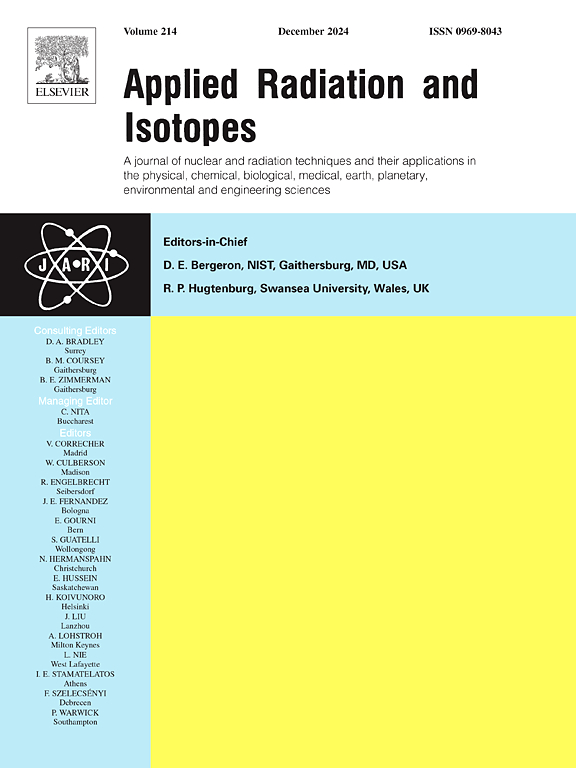Assessment of the level of uranium in groundwater and the role of public water purifiers in mitigating the concentration- A study from the south-western part of Bengaluru, Karnataka, India
IF 1.6
3区 工程技术
Q3 CHEMISTRY, INORGANIC & NUCLEAR
引用次数: 0
Abstract
Groundwater samples were gathered from various sites adjacent to Manchanabele Reservoir and their uranium concentration was measured using a Light Emitting Diode (LED) fluorimeter. The results show that the uranium concentration varied widely from 0.2 to 358.1 ppb, with a Geometric Mean (GM) of 16.51 ppb. According to the Atomic Energy Regulatory Board (AERB) and World Health Organization (WHO) standard values, high uranium concentrations are found in 23 % and 34 % of samples, respectively. Water samples from public water purifiers which use reverse osmosis were also taken from the same locations in order to comprehend the potential decrease in uranium content. The uranium concentration in these samples varied from 0.2 to 18.1 ppb, with a GM of 0.32 ppb. Every water sample taken from the water purifiers reveals a concentration that is well within the safe limit of 30 ppb. Uranium levels are found to be comparatively very less in purified waters than those collected directly from the borewells. From the measured concentration of uranium, the radiological risk parameters estimated in terms of lifetime cancer risk is in the range of 0.001x10−3 to 1.14x10−3 with GM of 0.05x10−3. The chemical toxicity risk measured as lifetime annual daily dose is found to range from 0.007 to 13.34 μg/kg/day with GM of 0.61 μg/kg/day for groundwater samples and 0.0006x10−3 to 0.05x10−3 with GM of 0.001x10−3, 0.0074–0.67 μg/kg/day with GM of 0.012 μg/kg/day for purified water samples. Annual Effective Dose (AED) for the different age group was estimated and the values for Infants, children and Adults are found to vary between 0.4 and 734.99 μSv/y with a GM of 33.88 μSv/y, 0.141–251.84 μSv/y with a GM of 11.61μSv/y and 0.17–310.60μSv/y with a GM of 14.32 μSv/y for groundwater samples and 0.41–37.14 μSv/y with GM of 0.65 μSv/y, 0.14–12.72 μSv/y with GM of 0.22 μSv/y, 0.17–15.69 μSv/y with GM of 0.27 μSv/y respectively for purified water samples. The physicochemical parameters like pH and Total Dissolved Solids (TDS) were also measured and the dependence of uranium concentration on these parameters has also been studied.
地下水中铀含量的评估和公共净水器在降低浓度方面的作用——来自印度卡纳塔克邦班加罗尔西南部的一项研究
从 Manchanabele 水库附近的不同地点采集了地下水样本,并使用发光二极管 (LED) 荧光仪测量了其铀浓度。结果显示,铀浓度在 0.2 至 358.1 ppb 之间变化很大,几何平均值 (GM) 为 16.51 ppb。根据原子能监管委员会(AERB)和世界卫生组织(WHO)的标准值,分别有 23% 和 34% 的样本中发现了高浓度的铀。为了了解铀含量下降的可能性,我们还在同一地点采集了使用反渗透技术的公共净水器的水样。这些样本中的铀浓度从 0.2 到 18.1 ppb 不等,平均值为 0.32 ppb。从净水器中提取的每个水样都显示其浓度远在 30 ppb 的安全限值之内。与直接从井中采集的水样相比,净化水中的铀含量非常低。根据测得的铀浓度,按终生致癌风险估算的辐射风险参数范围为 0.001x10-3 至 1.14x10-3,GM 值为 0.05x10-3。以终生年日剂量计算的化学毒性风险,地下水样本为 0.007 至 13.34 微克/千克/日,GM 值为 0.61 微克/千克/日;纯净水样本为 0.0006x10-3 至 0.05x10-3,GM 值为 0.001x10-3,0.0074-0.67 微克/千克/日,GM 值为 0.012 微克/千克/日。对不同年龄组的年有效剂量(AED)进行了估算,发现婴儿、儿童和成人的年有效剂量值介于 0.4 和 734.99 μSv/y 之间,GM 值为 33.88 μSv/y,0.141-251.84 μSv/y,GM 值为 11.61 μSv/y,0.17-310.60μSv/y。对于地下水样本,GM 值为 14.32 μSv/y,分别为 0.41-37.14 μSv/y(GM 值为 0.65 μSv/y)、0.14-12.72 μSv/y(GM 值为 0.22 μSv/y)和 0.17-15.69 μSv/y(GM 值为 0.27 μSv/y)。此外,还测量了 pH 值和总溶解固体 (TDS) 等理化参数,并研究了铀浓度与这些参数的关系。
本文章由计算机程序翻译,如有差异,请以英文原文为准。
求助全文
约1分钟内获得全文
求助全文
来源期刊

Applied Radiation and Isotopes
工程技术-核科学技术
CiteScore
3.00
自引率
12.50%
发文量
406
审稿时长
13.5 months
期刊介绍:
Applied Radiation and Isotopes provides a high quality medium for the publication of substantial, original and scientific and technological papers on the development and peaceful application of nuclear, radiation and radionuclide techniques in chemistry, physics, biochemistry, biology, medicine, security, engineering and in the earth, planetary and environmental sciences, all including dosimetry. Nuclear techniques are defined in the broadest sense and both experimental and theoretical papers are welcome. They include the development and use of α- and β-particles, X-rays and γ-rays, neutrons and other nuclear particles and radiations from all sources, including radionuclides, synchrotron sources, cyclotrons and reactors and from the natural environment.
The journal aims to publish papers with significance to an international audience, containing substantial novelty and scientific impact. The Editors reserve the rights to reject, with or without external review, papers that do not meet these criteria.
Papers dealing with radiation processing, i.e., where radiation is used to bring about a biological, chemical or physical change in a material, should be directed to our sister journal Radiation Physics and Chemistry.
 求助内容:
求助内容: 应助结果提醒方式:
应助结果提醒方式:


